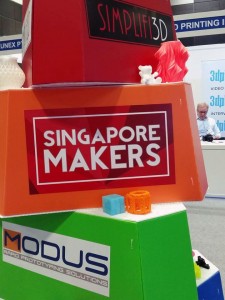Day 2 of the Singapore leg of the Inside 3D Printing Conference and Expo kicked off with a keynote, titled “Manufacturing the Future”, from Vice President and Chief Revenue Officer for 3D Systems, Michael Marchesan.
Following the intro talk came an awesome presentation on the use of 3D printing for humanitarian uses- 3D printed training materials for the removal of landmines and UXOs (unexploded ordnance). Luckily, Singapore is utterly free of such horrific problems, but the same cannot be said for all of South East Asia, and in particular, Cambodia. Enter Allen Dodgson Tan, Director of Phnom Penh-based Golden West Design Lab. Tan is a former US Army explosives expert, and is now applying that experience to the demining cause.

Why would they want to send replica mines through the post, I hear you ask? Well, because it is inadvisable to send live explosives through the post. Inadvisable and illegal. The Golden West solution offers full-scale, mechanically similar replicas to demining groups, allowing ordnance clearing teams the opportunity to work on realistic models and gain hands on experience before going into the (mine) field. Forewarned is forearmed after all, and familiarity with a certain type of hardware can literally mean the difference between life and death when it comes to a real life encounter in a demining situation. Good stuff!
Following Tan’s presentation, the expo hall opened up to the general populace of the convention at 10:30am, and I had the opportunity to walk around and chat with some of the home-grown Singaporean start-ups. The majority of the Singaporean companies were clustered together in an area designated as “Singapore Makers” and “One Maker Group”.

Singapore Makers is a loose community of makers and 3D printing enthusiasts, founded by William Hooi. One Maker Group (OMG) is a collective of 6 companies all focused on cultivating designers, entrepreneurs, and students. OMG have pushed this vision forward with the creation of a makerspace, in which they invite budding makers to partake in their custom-built educational curriculum and offer guidance on product development and design programs. The 6 companies of OMG are Simplifi3D, Sustainable Living Lab, Eian Williams Consulting, Home-Fix, Focustech Ventures, and SmartSpace.
Another Singapore-based company, named “RDP Labs Pte Ltd”, was conveniently located in the booth next to our own 3DPI area, meaning that my post-lunchtime, tea-saturated body didn’t have to waddle very far to speak to these folks.
RDP Labs are offering a desktop FDM printer in kit form, retailing for 1750 SGD, which they claim can provide the best performance at that pricepoint. Based on an Arduino, open source controller platform, their Falcon X-2 printer can have a number of parameters controlled ranging from flow rate to layer height, which they promise will offer an abundance of options for the user to optimize a print job. In 6 months time, an upgrade will be released which will allow the user to convert the current FDM hardware into a DLP (Digital Light Processing) resin0based platform for less than 1000 bucks, effectively allowing the user to own 2 different 3D printing systems for under 2700 SGD.
As the afternoon drew onwards, pretty much everyone in attendance was awaiting the talk from Javier Larraz of Hewlett Packard, a company that has long been rumored to be entering the 3D printer game with their “Multi Jet Fusion Technology”. HP appear to be playing their cards very close to their chest at this point, as evidenced by the lack of technical details available in the presentation. Albeit, this is understandable, as the HP product is still under development. What HP has promised, however, is an inkjet-based system with unrivalled speed, built on their many years of experience in the traditional printing industry.
Larraz compared the speed of their new system to the speed of printing books with digital printers, and quoted a fairly staggering 30 million dots-per-second-per-inch, as a baseline speed for their 3D printer. In addition, low rates of DPR (Dot Placement Error) were promised, with Larraz telling us that high levels of precision and accuracy would be achieved at the voxel level.

In an interview with 3DPI after the talk, Larraz was kind enough to clarify what he meant by “collaborative”, and told us that HP would effectively be licensing the bonding agent, certifying it, and working with their partners in order to develop the agent so that it is optimized for a wider range of powder substrates. This feedback loop will enable HP to modify their chemical agents as new plastic powders are experimented with and will enable them to stay ahead of the curve in terms of new materials.
So, there you have it. HP is talking a big game, and has clearly put a lot of thought into this. They may be deliberately vague on the technical elements at the moment, but they seem to understand that there is no point in flooding the market with yet more FDM machines. Instead, they are focusing on removing some of the current hurdles that are preventing 3D printing from becoming truly mainstream, i.e the speed of the process itself and the lack of materials available, which are currently in the region of 250 printable materials worldwide.
We spoke with representatives of both 3D Systems and Stratasys who were not only completely stoked by the presentation, but had nothing but good will towards HP as they enter the marketplace, which has so far been dominated by the 2 “newcomers”. That says a lot about this industry really. The maker spirit and sense of community is not just limited to those making Iron Man masks and comedically-oversized cosplay weaponry on their Makerbot machines, but seems to permeate the entire industry, right to the very top. And that is both refreshing, and also very cool.
And so ends the second Inside 3D Printing Conference and Expo at the Singapore Suntec Convention Centre. The final visitor numbers are in and total 2500 compared to last year’s 1700, with the most popular talks being the intro keynote from Professor Chua Chee Kai (NTU), and Javier Larraz from HP. In the final article covering the 2-day event, we will share the gossip from Camp Stratasys, who were kind enough to sit down with 3DPI for a 30 minute chin-wag, regarding the future plans and current philosophy of the company. So, stay tuned.



